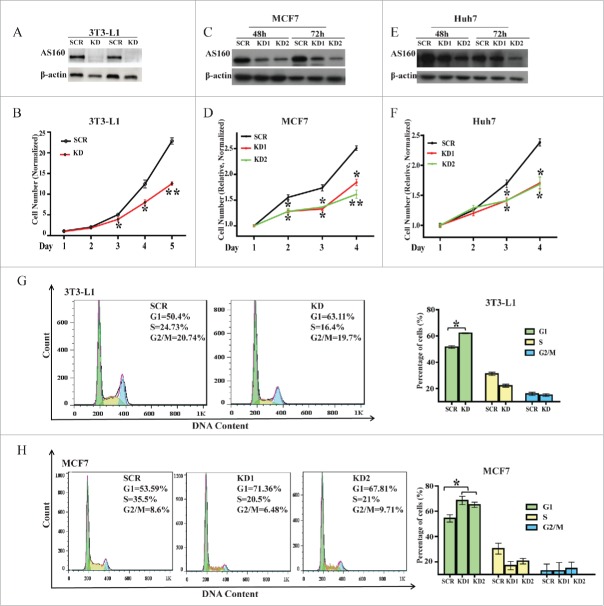Figure 1.
AS160 silencing suppresses cell proliferation and induces cell cycle arrest in the G1 phase in multiple cell types. (A) Levels of the indicated protein in 3T3-L1 fibroblasts infected with a scrambled (SCR) or AS160-specific shRNA (KD) were determined by performing protein gel blotting with duplicate sample loading; β-actin served as a loading control. (B) Proliferation of cells from (A) was determined by counting cells and normalizing the numbers relative to the initial cell numbers. Data represent mean ± s.e.m. (n = 3 represents 3 replicated experiments, same below); here and below, *p < 0.05 and **p < 0.01 compared to SCR, 2-tailed t test. (C) Western blots of MCF7 cells transfected with 2 AS160 siRNAs (KD1 and KD2) or scrambled siRNA (SCR), at 48 and 72 h post-transfection. (D) Proliferation levels of MCF7 cells from (C) were determined using the MTS assay and normalized relative to the respective initial OD values. Data represent mean ± s.e.m. (n = 3). (E) Western blots of Huh7 cells transfected with 2 AS160 siRNAs (KD1 and KD2) or scrambled siRNA (SCR), at 48 and 72 h post-transfection. (F) Proliferation levels of Huh7 cells from (E) were determined using the MTS assay and normalized relative to the respective initial OD values. Data represent mean ± s.e.m. (n = 3). (G) Cell cycle analysis of SCR and KD 3T3-L1 fibroblasts. Results represent percentages of cells in G1, S, and G2/M phases for the representative experiment (left) and mean ± s.e.m. (right, n = 3); here and below, *p < 0.05 compared to SCR, t test. (H) Cell cycle analysis of MCF7 cells transfected with 2 AS160 siRNAs (KD1 and KD2) or scrambled siRNA (SCR).

